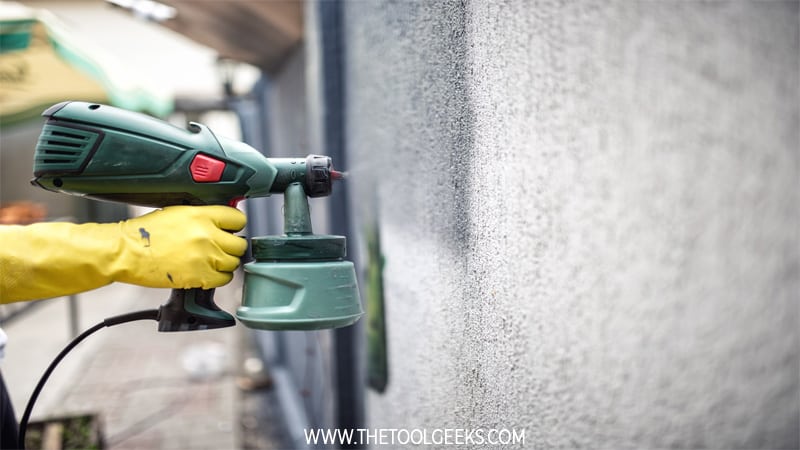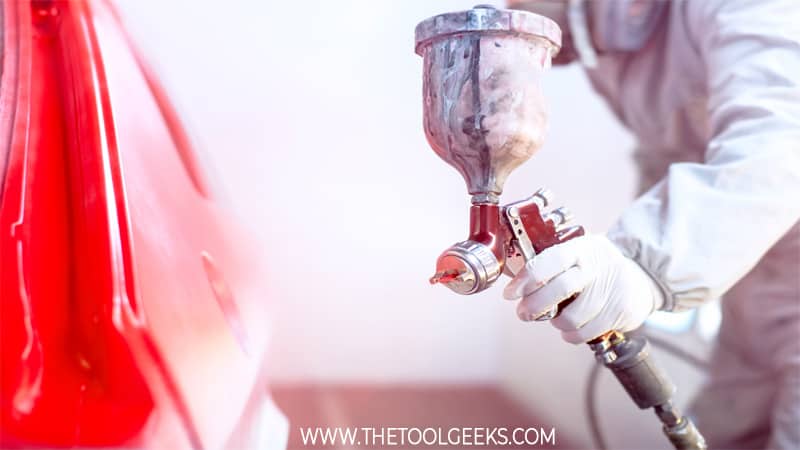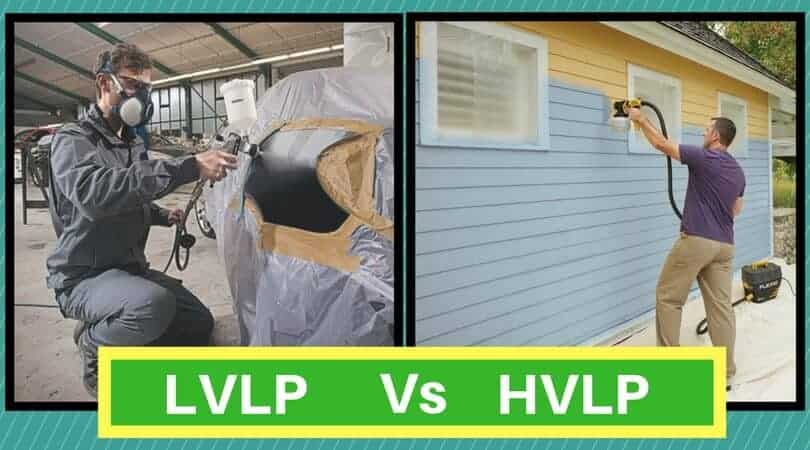LVLP Spray Guns Vs HVLP Spray Guns – What is the difference?
TheToolGeeks.com is a participant in the Amazon Services LLC Associates Program and other affiliate advertising programs. We may earn from qualifying purchases. (Learn More).
There are a lot of different spray guns, which makes you have a harder job in finding the one you actually need. Today I’m going to explain the difference between LVLP spray guns vs HVLP spray guns.
The main difference between LVLP vs HVLP sprayers is the pressure they use. The LVLP sprayers use less air pressure (10-30 PSI) than HVLP sprayers (40-60 PSI), and less air volume (5-18 CFM) than a HVLP sprayer (10-30 CFM).
But that’s not all. Let’s see which one of these sprayers is better, and which one you need.
Note: If you don’t own an HVLP or an LVLP spray gun, here you can check our list of the best lvlp spray guns and the best hvlp spray guns for woodworking
What are HVLP Spray Guns?

Today one of the most used spray guns are the HVLP spray guns. The “HVLP” stands for “High Volume Low Pressure”. In other words, it produces a high volume output while using very little pressure.
This means you will be able to control the spray gun easier and at the same time you will be spending much less material while the color quality will be very high.
Of course, it consumes a lot more energy if you compare it to an LVLP spray gun because it uses more compressed air. This kind of spray guns mostly produces somewhere near 100 CFM at 4-9 CFM.
HVLP spray guns are mostly used for professional work. If you work in a garage then you need to use HVLP spray guns because they are more eco-friendly.
One of the many reasons why this happens is because the government has obligated many of the HVLP units to design the spray guns in that way to protect the environment.
Among many other features that HVLP spray guns have the best one is that it saves a lot of your material. There is very little over-spray and the paint transfer rate is somewhere near 70%– which means there’s little to no wasted paint.
Related Read — HVLP vs. Airless
Since HVLP spray guns are good and are the most used spray guns on the market that means that there are a lot of guides, videos that will help you to understand how they work and how to use them. We have also written a lot of guides as well for spray guns which will help you a lot.
Our favorite HVLP Spray gun:
HomeRight Super Finish Max C800971

Read more in an In-depth review of the HomeRight Super Finish Max C800971.
What Are LVLP Spray Guns?

On this website, we have talked a lot about LVLP spray guns because they are the most used tool by us and many people. The LVLP stands for “Low Volume Low Pressure”. If you are looking for a spray gun that will fulfill all your needs then this is your go.
The best feature that this spray gun has, is that it has a really good transfer efficiency. Which in other words means that there won’t be any wasted paint and the color quality will the high.
The biggest difference between HVLP spray guns and LVLP spray guns is that LVLP spray guns need a lower amount of PSI in order to work perfectly (10 PSI), you can use almost any air compressor and the LVLP spray gun will still work perfectly.
Almost every air compressor on the market will do for lvlp spray guns, even the cheapest one. But using cheap and low-quality air compressors is not recommended because the air compressor is one of the most vital elements that help the spray gun performance.
Related Read — How To Get Rid of Paint Smells?
Using a low-quality air compressor may affect the color quality. In other words, cheap quality compressors may end up being more expensive than the high-quality ones because you may end up re-painting the object if you get a bad quality color. If you are planning to paint thicker object then lvlp are not recommended.
Related Read — Can You Spray a Car with a LVLP Sprayer?
Our Favorite LVLP Spray Gun:
Astro GF20S Gravity Feed Spray Gun Currently Unavailable
HVLP vs. LVLP: Head to Head
Both of these tools are good. But, there are areas where the LVLP is better than HVLP spray guns and vice versa. Let’s put these two tools head to head and see who wins.
Pressure Used:
If we compare the pressure used, then the LVLP spray gun uses way less pressure than an HVLP spray gun. The LVLP spray gun can operate with 10-30 PSI, while the HVLP spray gun needs 40-60 PSI.
This also means that you need a more powerful air compressor to use HVLP spray guns. LVLP spray guns don’t need a powerful air compressor. As long as the compressor can offer 10 PSI then you are good to go.
Transfer Efficiency:
Transfer efficiency (TE) is measured with percentage. In other words, it calculates how much paint goes into the surface you are painting, and how much goes into the air. The higher the transfer efficiency is the better.
A higher TE means that the spray gun doesn’t waste paint, and it protects the environment. The HVLP spray guns have a 60-70% transfer efficiency, while the LVLP’s have a lower rate. That’s why HVLP spray guns are mostly used indoors because very little paint goes into the air.
Speed:
The main reason people use spray guns is to complete a project faster. So, it’s only necessary to compare the speed between HVLP spray guns and LVLP spray guns.
HVLP spray guns are faster than LVLP spray guns and that’s because the HVLP spray guns use more pressure and have larger air holes. Plus, the transfer efficiency is higher and that helps to cover a larger surface faster.
But, that doesn’t mean LVLP spray guns are very slow. The LVLP spray guns are a lot of times faster than a traditional sprayer.
Paints You Can Spray:
When it comes to paint types you can spray then there’s no winner. Both of the sprayers can spray any kind of paint– as long as your tip size is correct, your paint mixture is correct, and you have enough air volume.
Final Words
Both of these spray guns are high quality, it all depends on what you will use them and it depends on your own preferences. If you want to paint spray your kitchen cabinets then make sure to check our paint sprayers for kitchen cabinets review
Amazon and the Amazon logo are trademarks of Amazon.com, Inc, or its affiliates.

